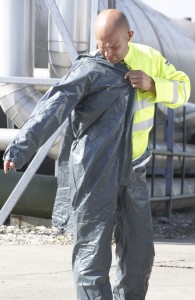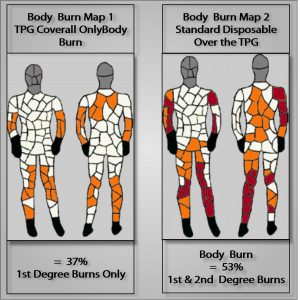![]() Increasingly in India – as well as in other parts of the world including the Middle East, Australasia and South America, the European CE standards are selected and required by users serious about protection as the benchmark for quality personal protective equipment and for products that provide the required protection in many situations throughout industry.
Increasingly in India – as well as in other parts of the world including the Middle East, Australasia and South America, the European CE standards are selected and required by users serious about protection as the benchmark for quality personal protective equipment and for products that provide the required protection in many situations throughout industry.
CE standards provide a guide to the MINIMUM requirements for PPE. However, many of those standards are too often considered in isolation and users need to give greater consideration of how different PPE works together.
Standards identify types of protection as neat, separate issues… protection against chemicals; or protection against heat and flame; or protection against arc flash and so on. This is convenient… but unrealistic. Applications often feature more than one hazard; for example on a petrochemical plant protection might be needed against chemical and heat and arc flash. Most users have to deal not with single but with multiple hazards.
The obvious solution is to “marry” protection types by combining PPE. But is this a marriage made in heaven? Or is it a route to PPE hell? Will the properties of one affect those of the other? This can and does happen, and users should be aware of the possible dangers that might result…
 There two variations of this problem:
There two variations of this problem:
- Two types of PPE must be worn protecting different parts of the body
- Two types of protection must be worn on the same part of the body to provide different types of protection
Dealing with the first of these is simple. Optimal compatibility between different PPE is primarily the responsibility of manufacturers. For users the question is “How well do different PPE items work together?” For example, how well does a coverall hood fit to the rim of a face mask? Or how effective is the join between the sleeves of the suit and the chemical gloves? Often solutions are improvised, such as taping up the joins with adhesive tape. However, such solutions are untested and it is worthwhile seeking better ones – such as hoods with a superior fit and a glove connection system.
The Dangers of combining PPE
Addressing the second variation is more problematic, partly because problems are less obvious, but also because a solution may not be readily available. In protective clothing, a good example is the practice of wearing a standard disposable chemical suit OVER a suit designed to protect against thermal hazards.
Many users must wear a Thermal Protective Garment – a “TPG” (such as a Nomex®, FR cotton or similar) to protect against the risk of flame and heat hazards. However, many applications also require chemical protection and the too-often used solution is to wear a chemical suit OVER the TPG. This can also be done because TPG’s are expensive and laundering is costly and reduces lifespan, so a standard disposable worn over it seems an effective way of minimising cost. This solution however is a serious problem that could compromise the thermal protection provided – perhaps critically.
 Thermal protective garments work by creating a barrier to heat energy between the source of the heat and the wearers’ skin. However, standard chemical suits will ignite and burn, drip molten, burning debris and adhere to surfaces – including the fabric of the TPG suit worn beneath. Furthermore, disposable suits are constructed of thermo-plastic materials which absorb heat energy and release it slowly over time – molten polypropylene and polyethylene will continue to release heat energy long after it ceases to combust.
Thermal protective garments work by creating a barrier to heat energy between the source of the heat and the wearers’ skin. However, standard chemical suits will ignite and burn, drip molten, burning debris and adhere to surfaces – including the fabric of the TPG suit worn beneath. Furthermore, disposable suits are constructed of thermo-plastic materials which absorb heat energy and release it slowly over time – molten polypropylene and polyethylene will continue to release heat energy long after it ceases to combust.
The result is that heat energy is transferred through to the skin of the wearer long after the heat source is extinguished. It also blocks up the pores in the TPG fabric weave, creating a “greenhouse effect”, holding the heat energy against the wearers’ skin. In other words the disposable coverall itself becomes an effective heat source whilst destroying the thermal protection offered by the TPG.
This is not just theoretical. Thermal Mannequin Testing indicates the effectiveness of TPG’s by using artificial “flash fire” to predict the extent of 1st and 2nd degree body burn. Independent testing of various chemical suits worn over thermal protective garments has been conducted. The results are startling:-
Predicted body burn for the TPG alone was 37% with 1st degree burns only (Body Burn Map 1). But with a standard disposable coverall over it predicted body burn increased to 53% with extensive 2nd degree burning (Body Burn Map 2). The red areas indicate where the 2nd degree burns occurred… primarily on the arms and legs, precisely where in the test video, the disposable polymer can be seen continuing to burn long after the ignition source was extinguished. This increase in body burn – 37% to 53% – and the deeper burns involved could easily be the difference between life and death.
 Fortunately there is a solution. Properly designed FR disposables are available to replace standard disposables. The final body burn map (Body Burn Map 3) is from the same test series, and features a Pyrolon CRFR, a chemical suit designed specifically to be FR, worn over the TPG:-
Fortunately there is a solution. Properly designed FR disposables are available to replace standard disposables. The final body burn map (Body Burn Map 3) is from the same test series, and features a Pyrolon CRFR, a chemical suit designed specifically to be FR, worn over the TPG:-
In this case not only are burns 1st degree only, the predicted body burn has reduced to 24%. So the thermal protection has substantially improved.
The important point is that when marrying different PPE, users should always check whether the use of one has any effect on the performance of the other, and if so, to seek a solution that ensures the marriage is for better and not for worse. With the correct partner, it can even be a marriage made, if not in heaven, then at least for life….
Martin Lill is Director of International Marketing for Lakeland Industries Inc., a leading global manufacturer of protective clothing. He has over 25 years of experience in the design, development and sale of a range of protective clothing, both with Lakeland and another global manufacturer with specialised knowledge in disposable and chemical clothing.















































